When an initiate is first brought to light, the radiance comes from the Three Lesser Lights, which form a triangle about or near the altar.
Lesser Lights are lit when the lodge is opened and the altar arranged, and extinguished when the lodge is closed and the Great Lights displaced. Something – not very much – is said of them in the ritual.
They form one of those symbols in Freemasonry – of which there are so many! – which the individual brother is supposed to examine and translate for himself, getting from it what he can and enjoying what he gets in direct proportion to the amount of labour and thought he is willing to devote to the process of extracting the meaning from the outer covering.
In some jurisdictions, the Lesser Lights are closely about the altar; in others one is placed at each of the stations of the three Principal Officers.
In some lodges the Three Lesser Lights form a right, in others an equilateral, in others an isosceles triangle.
What is uniform throughout the Masonic world is the triangular formation; what is different is the shape and size of the triangle.
Of course, it is not possible to place three lights to form anything else but a triangle; they cannot be made to form a square or a star.
Hence the natural question:
![]()
why are there
three Lesser Lights
and not two
or four or more?

There is ‘three’ throughout Ancient Craft Masonry. The first of the great Sacred Numbers of the Ancient Mysteries, three was the numerical symbol of God, but not because God was necessarily considered as triune.
While many religions of many ages and peoples have conceived of Divinity as a trinity, the figure three as a symbol of God is far older than any trinitarian doctrine.
The triangle, like the circle, is without beginning or ending. One line, or two lines, have ends. They start and finish. Like the square or the five or more sided figure, the triangle has no loose ends.
And the triangle is the first of these which can be made; as God was always considered as first, and also as without either beginning or ending, the triangle itself soon became a symbol of Deity.
Ancient peoples made much of sex. Their two greatest impulses were self-preservation and mating. Their third was protection of children.
So powerful were these in primal man that not all his civilization, his luxury, his complicated and involved life, have succeeded in removing them as the principal main-springs of all human endeavour.
It was natural for the savage worshipper of a shining god in the sky to think he, too, required a mate, especially when that mate was so plainly in evidence.
The Moon became the Sun’s bride by a process of reasoning as plain as it was childlike.

The Moon, Sun and Mercury depicted in alchemical symbolism – A red-faced king stands in a red robe, flanked by a queen and the deity Mercury in green clothes; representing a stage in the process of alchemy. Coloured etching, ca. 18th century.
IMAGE LINKED: wellcome collection Attribution 4.0 International (CC BY 4.0)
Father, mother… there must be a child, of course. That child was Mercury, the nearest planet to the sun, the one the god kept closest to him.
Here we have the origin of the Three Lesser Lights; in earliest recorded accounts of the Mysteries of Eleusis (to mention only one) we find three lights about the holy place, representing the Sun, the Moon, and Mercury.
The Worshipful Master rules and governs his lodge as truly as the Sun and Moon rule and govern day and night.
There can be no lodge without a Worshipful Master; he is, in a very real sense, the lodge itself.
There are some things he cannot do that the brethren under him can do. But without him the brethren can do nothing, while without the brethren’s consent or even their assistance, he can do much.
As one of the principal functions of the Worshipful Master is to give ‘good and wholesome instruction’ to his lodge, the inclusion of one light as his symbol is but a logical carrying out of that Masonic doctrine which makes the East the source of Masonic light to the brethren.
By the light of the Lesser Lights the Entered Apprentice is led to see those objects which mean so much to a Mason, the Great Lights; the inestimable gift of God to man as the rule and guide for his faith and practice, the tools dedicated to the Craft and to the Master, the Alpha and Omega of Freemasonry.
Light alone is not enough; light must be used! Here, too, is symbolism which it is well to muse upon.
As the lodge as a whole is a symbol of the world, so should a Mason’s heart be to him always a symbol of the lodge.
In it he should carry ever what he may remember of the Great Light and with spiritual compasses lay out his work; with spiritual square, square both work and actions toward all mankind, ‘more especially a brother Mason’.
Therefore must he carry also in his heart three tiny Lesser Lights, by the light of which he uses his spiritual lodge furnishings.
If he lights these from the torch of love and burns one for friendliness, one for helpfulness and one for godliness, he will be truly an initiate in the real sense of that term, and about the altar of Freemasonry find a new satisfaction in the new meanings which the Three Lesser Lights will, with silent light and soft, imprint upon his heart.

Article by: Carl H. Claudy
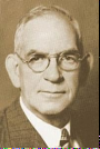
Carl Harry Claudy (1879 – 1957) was an American author, magazine writer, and journalist for the New York Herald.
His association with Freemasonry began in 1908, when, at the age of 29, he was raised a master Mason in lodge Harmony No. 17 in Washington, DC. He served as its master in 1932 and eventually served as Grand Master of Masons in the District of Colombia in 1943.
His Masonic writing career began in earnest when he became associated with the Masonic service Association in 1923, serving as associate editor of its magazine, The master mason, until 1931.
Under his leadership the service Association was brought to a place of predominance through his authorship and distribution of the short talk bulletin which made his name familiar to virtually every lodge in the country.
 Old Tiler Talks - Eyes Lifted High The Old Tiler Talks first published in 1925, by Carl Claudy, is a series of short anecdotal stories told in the setting of a new member asking an old tiler for his opinion on various masonic topics. These short articles are still very relevant, 100 years on, and hopefully provide some insight to new members today. |
 Old Tiler Talks - Masonic Libraries The Old Tilers talks first published in 1925, by Carl Claudy, is a series of short anecdotal stories told in the setting of a new member asking an old tiler for his opinion on various masonic topics. These short articles are still very relevant, 100 years on, and hopefully provide some insight to new members today. |
 Old Tiler Talks - So Many Rascals "Why are there so many rascals in the Fraternity, and why don't we turn them out?" a new member voiced to the old tiler for his opinion. These short articles are still very relevant, 100 years on, and hopefully provide some insight to new members today. |
 Old Tiler Talks - The Greatest Work The Old Tiler asked, "what is the greatest work of Masonry?" The New Brother sat by the guardian of the door and pulled out his cigar case. - Another instalment of wisdom by Carl Claudy, The Greatest Work |
 Old Tiler Talks - Why Men Love Freemasonry The 'Old Tiler Talks' first published in 1925, by Carl Claudy, is a series of short anecdotal stories told in the setting of a new member asking an old Tiler for his opinion on various Masonic topics. These short articles are still very relevant, 100 years on, and hopefully provide some insight to new members today. |
 Old Tiler Talks - Seeking a Little Light The Old Tilers talks first published in 1925, by Carl Claudy, is a series of short anecdotal stories told in the setting of a new member asking an old tiler for his opinion on various masonic topics. These short articles are still very relevant, 100 years on, and hopefully provide some insight to new members today. |
 The new mason laments that practically speaking, Masonry is a failure, and it depresses me … Masonry cannot be a failure, because men fail as Masons. The Old Tilers talk by Carl Claudy |
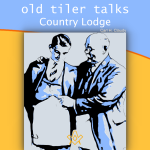 Old Tiler Talks - Country Lodge A lesson in the importance of an open mindset to observe, not to judge, but to learn and accept that we can achieve the desired outcome employing a different process. by Carl Claudy |
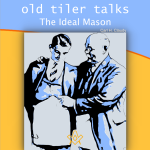 Old Tiler Talks - The Ideal Mason "What's your ideal of Freemasonry?" asked the Younger Mason - A short anecdotal story told in the setting of a new member asking an old tiler for his opinion on various masonic topics by Carl Claudy |
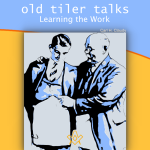 Old Tiler Talks - Learning the Work A short anecdotal story told in the setting of a new member asking an old tiler for his opinion on various masonic topics by Carl Claudy |
 Masonic first appointments and promotions might appear to be inequitable for one point a view, but some times, one point does not show the whole picture. A perfectly articulated story by Claudy, we should not compare one persons abilities with another. |
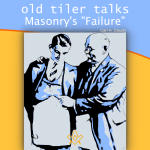 Old Tiler Talks - Masonry's 'Failure' Masonry fails because it doesn’t interest men sufficiently to make them practice what they preach. A perfectly articulated story by Claudy Masonry does not fail men. Men fail Masonry. Masonry has the teachings. |
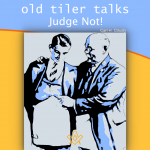 A perfectly articulated story by Claudy reminds us of a lesson from the Second Degree Charge; in the decision of every trespass against our rules, judge with candour, admonish with friendship, and reprehend with mercy. |
 Old Tiler Talks - A Masonic Speech A Masonic Speech - I can tell you the essence of appeal. It is drama. If you want your hearers to hang on your words, dramatize your subject |
 Old Tiler Talks - A Mason's Christmas A Mason's Christmas - Do you believe in Christmas celebrations should be held by the lodge ? Should members be asked to contribute to one and engage in Christmas festivities ? What is the old tilers take on this ? |
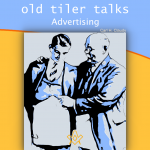 Advertising - We would do more good in the world if we advertised ourselves more… Why ? |
 Uncover the mystery behind one of the oldest and most widespread symbols denoting God. |
 Do you want to discover the originals of the five points of fellowship ? |
 The mystery behind the two great pillars that stood at the porchway entrance of King Solomon Temple |
 Three numbers, what are their masonic significance? Pythagoras has something to say about them |
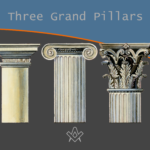 What are the Three Grand Pillars ?, wisdom, strength, and beauty - then later we hear of the Doric, Ionic, and Corinthian columns |
 This emblem contains more real food for thought than any other in the lecture of the Sublime Degree. |
 The Hiramic Legend is the glory of Freemasonry; the search for that which was lost is the glory of life |
 How are the Fellowcraft's five steps connected the five senses of human nature |
 How to explain the principle tents of the craft to a newly made brother |
 What are the lesser lights and where are they placed on our Lodges |
 Like so much else in Freemasonry the Middle Chamber is wholly symbolic |
 In the true sense of the words Freemasonry is not a secret society but a society with secrets. |
 Three Great Lights – the Volume of the Sacred Law, the Square, and the Compasses |
 Entered Apprentice Lambskin Apron; More ancient than the Golden Fleece or Roman Eagle, more honourable than the Star and Garter ... |
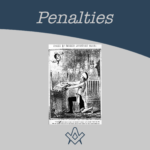 To the initiate, the penalty in his obligation comes with a shock of surprise and sometimes consternation. |
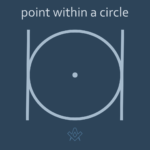 What is a point within a circle |
masonic knowledge
to be a better citizen of the world
share the square with two brothers

click image to open email app on mobile device








